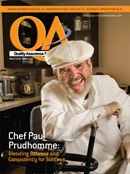Walls can be essential components of a food plant’s food safety and defense programs, reducing the potential of cross contamination and enhancing security efforts. But when these walls are erected in the communication between managers, departments or employees, they can affect the business process and reduce efficiencies across the plant.
In 2004, The Bama Companies, a proprietary dough products and baked goods manufacturer in Tulsa, Okla., was awarded the Malcolm Baldrige National Quality Award.
“If we don’t communicate where we are going, the roadmap to get there, and what we are going to do along the way, we just about guarantee failure,” said Bama’s Six Sigma Master Black Belt Mike Frihart. “Likewise, if we don’t listen to our people, those who have all of this process knowledge and wisdom, we will have no idea what we are doing well and where we are falling short. This applies to the quality of products, services, processes, plans and even ideas.”
And, he added, it is just as important to train employees on good communication as it is to train them on the plant practices and processes. Frihart detailed some of the company’s best practices in cross-departmental communication and training:
1. In our manufacturing plants all the facility’s department managers and key personnel have offices in the same hallway. When you see each other every day it is much easier to talk.
2. We sit down weekly to review data and priorities to ensure appropriate alignment of resources. An example of this would be the coordinating of vacation schedules, to align staffing of our production lines. Because we are a continuous operation, if we won’t have enough people to staff all lines, we need to know that so that we can plan on the slowing or stopping of a line or lines.
3. At the “corporate level,” a weekly communication PowerPoint file is sent to all managers, and each is responsible for getting the information to their direct reports. It is a brief communiqué — four to six slides discussing recent events and upcoming plans related to our four areas of organizational focus: people, customers, process improvement and the financial end of things that we label “smart, fun growth.”
4. We added a question to our last employee survey to assess the effectiveness of our business communication. The survey item reads, “Bama provides me with relevant information about our business.” Because the data indicate that we continue to have opportunities for improvement in this area, we have reviewed our communications efforts and come to realize that with more and more young employees, it is time for us to put on different hats. As a result, we are deploying alternative communication methods to fit with the computer practices of today’s youth. We have a number of computers in the breakroom and are developing communication updates, videos and rolling slide shows for employees.
5. At the interpersonal level, all employees are trained on the concept of EQ, or emotional intelligence, from their first day on the job, and it is continuously reinforced. In layman’s terms, this means that we’re encouraging people to behave nicely. It includes teaching them how to have “courageous conversations” which are intended to help people communicate more effectively about issues, specific behaviors to correct, recognition/appreciation, joint problem solving or relationship building. To effectively navigate difficult conversations, employees are taught to be direct in their conversations, while remaining open minded and discussing issues in positive ways so as not to destroy another’s ego or make him or her mad. The tool is effective for all business, and personal, discussions.
6. Each shift conducts a “cross-over” meeting (we run 24/7) to transfer key information between shifts. Attendance is mandatory. There is a set agenda: safety, quality, productivity.
Asked, “Why do you spend so much training your employees? Won’t they just leave?” The answer, Frihart said, would be “What if we don’t train them and they stay?”
To which, he then added, only half tongue-in-cheek ,“If the people reading your article do not believe that good communication is essential to competitiveness, I can only hope they are our competitors.”
The author is Staff Editor of QA magazine.

Explore the June 2008 Issue
Check out more from this issue and find your next story to read.
Latest from Quality Assurance & Food Safety
- Chef Robotics Introduces Pat-Down Capability for Meal Presentation and Sealing
- USDA Launches Regenerative Pilot Program
- Indoor Ag-Con Adds Food Safety Track to Conference Lineup
- IDFA Recognizes Federal Officials for Support of U.S. Dairy Industry
- Tetra Pak Acquires Bioreactors.net
- Fresh Del Monte Receives Rabobank Leadership Award
- São Paulo Earns Guinness World Record for Largest Municipal Food Security Program
- KPM Analytics Releases Ready-to-Use NIR Calibration Packages





